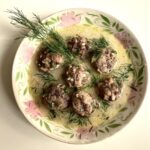 Succulent spicy meatballs served in broth with cream and topped with fresh dill — now that’s what I call comfort food with a capital C, except that this dish is light, not heavy. I first made it on a winter’s evening and have since repeated it many times as it proved very popular here at home. What inspired this creation? I may have had Swedish meatballs on my mind, but I added cumin, ground coriander, cayenne and cilantro to spice things up a bit…
Succulent spicy meatballs served in broth with cream and topped with fresh dill — now that’s what I call comfort food with a capital C, except that this dish is light, not heavy. I first made it on a winter’s evening and have since repeated it many times as it proved very popular here at home. What inspired this creation? I may have had Swedish meatballs on my mind, but I added cumin, ground coriander, cayenne and cilantro to spice things up a bit…
Boulettes épicées au bouillon / Spicy meatballs in broth
… and then –inspiration! — heated up some chicken broth, swirled in a couple spoonfuls of crème fraîche, added the meatballs and, just before serving, snipped fresh dill on top. This could probably be called a fusion dish as it combines flavors from various parts of the world. The cream and dill evoke Russian cuisine, the meatballs evoke the Middle East and Italy as well as Sweden. And, as I made it in my Paris kitchen, it’s also French (imho)…
So, to get down to specifics. The meatballs are made of a mixture of ground beef and pork (sausage meat), with onion and garlic in addition to the spices. I roasted the meatballs in the oven, which is lighter than frying and has the advantage of ensuring that they keep their shape. I then heated up some homemade chicken broth, which I make regularly and keep in small quantities in my freezer — for occasions just such as this.
When the meatballs came out of the oven, I swirled the cream into the broth (more = better), then added the meatballs with their juices. The final touch was the fresh dill. My daughter prefers these meatballs over rice, while I prefer them on their own. A chacun son goût, as they say (rough translation: ‘Whatever turns you on’).
This is the sort of meal that’s very easy to prepare, providing you have the broth on hand. I made it last weekend when I got back from England and needed a quick suppertime dish. And what about England? People keep asking me about the weather. Well, rainy, blustery, biting cold with the occasional sunny spell, but you don’t go to England for the weather. You didn’t used to go to England for the food either, but that has now changed.
I had some fabulous meals over there, and will mention just a few. An incredible Brazilian-style stew of monkfish in a tomato-onion-pepper and coconut milk sauce (recipe coming soon), Trinidad and Tobago-style spicy fish fritters, a vegetable dish of wild garlic, kale and other greens gathered in my friend’s London allotment (garden patch), a creamy soup of nettles picked by another friend during a woodland walk. Now that’s creative cuisine…
Happy cooking!

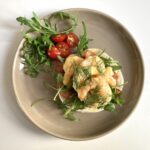 This open-face pita sandwich with shrimp in curried mayo set on a bed of bacon and arugula and topped with fresh dill is an example of why I have often thought this site should be renamed ‘Meg Has Lunch’. Like many dishes proposed by The Everyday French Chef, it was invented one day when I went into the kitchen at lunchtime wondering what to make, checked the fridge to see what we had on hand and came up with a felicitous combination.
This open-face pita sandwich with shrimp in curried mayo set on a bed of bacon and arugula and topped with fresh dill is an example of why I have often thought this site should be renamed ‘Meg Has Lunch’. Like many dishes proposed by The Everyday French Chef, it was invented one day when I went into the kitchen at lunchtime wondering what to make, checked the fridge to see what we had on hand and came up with a felicitous combination. With Easter just around the corner, here are some seasonal recipes you may wish to try for a holiday meal:
With Easter just around the corner, here are some seasonal recipes you may wish to try for a holiday meal:  Longing for a hint of spring as the Paris winter drags on and on, I made a cheery pot of risotto with peas and fresh mint the other day. The inspiration for this dish was not my own. I first had it last summer at a beautiful English country pub,
Longing for a hint of spring as the Paris winter drags on and on, I made a cheery pot of risotto with peas and fresh mint the other day. The inspiration for this dish was not my own. I first had it last summer at a beautiful English country pub, 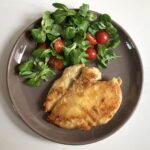 Making parmesan chicken, a family favorite, is simplicity itself. There are only two ingredients — the parmesan and the chicken (plus a little olive oil for pan-frying). Unlike other similar dishes where chicken is coated before frying, this lighter version involves no flour, no breadcrumbs, no egg. The grated parmesan is simply patted onto the chicken breasts, which are then lightly fried until golden, et voilà — dinner is served.
Making parmesan chicken, a family favorite, is simplicity itself. There are only two ingredients — the parmesan and the chicken (plus a little olive oil for pan-frying). Unlike other similar dishes where chicken is coated before frying, this lighter version involves no flour, no breadcrumbs, no egg. The grated parmesan is simply patted onto the chicken breasts, which are then lightly fried until golden, et voilà — dinner is served. This salad of curly endive with bacon is a French bistro classic and it’s one of my favorites. I often serve it to friends at dinner parties, usually followed by another bistro dish, for example
This salad of curly endive with bacon is a French bistro classic and it’s one of my favorites. I often serve it to friends at dinner parties, usually followed by another bistro dish, for example  Let’s start with the lettuce. Salade frisée is displayed proudly in French farmers markets, its yellow heart framed by a dark green crown. This type of salad is huge. It can measure up to two feet (60 cm) in diameter when spread open. When I took the photo at right, it virtually covered the picnic table on my veranda. So unless you are cooking for an army, you won’t need all of it for your salad. What to do with the rest? Either a repeat performance or you can use it to make Italian lettuce soup, a recipe I hope to post one day soon.
Let’s start with the lettuce. Salade frisée is displayed proudly in French farmers markets, its yellow heart framed by a dark green crown. This type of salad is huge. It can measure up to two feet (60 cm) in diameter when spread open. When I took the photo at right, it virtually covered the picnic table on my veranda. So unless you are cooking for an army, you won’t need all of it for your salad. What to do with the rest? Either a repeat performance or you can use it to make Italian lettuce soup, a recipe I hope to post one day soon. Now the bacon. In France lardons, or bacon sticks, are sold precut in supermarkets. But for best results with this salad, it’s preferable to start with a thick strip of bacon — about 1/3 inch (1 cm) — and cut the lardons yourself. The flavor and texture are better, and your guests will appreciate it. If that’s not possible where you live, buy thick-cut bacon strips and chop them. My advice: be generous with the bacon. It’s the star of the show.
Now the bacon. In France lardons, or bacon sticks, are sold precut in supermarkets. But for best results with this salad, it’s preferable to start with a thick strip of bacon — about 1/3 inch (1 cm) — and cut the lardons yourself. The flavor and texture are better, and your guests will appreciate it. If that’s not possible where you live, buy thick-cut bacon strips and chop them. My advice: be generous with the bacon. It’s the star of the show.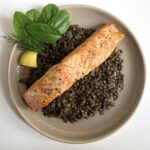 Roasted salmon on a bed of spicy lentils is a dish that delivers the comfort we crave in winter without too much heft. Here, the dish is paired with spinach for a combination that’s as pleasing to the eye as to the palette. I made this dish last week during a cold snap in Paris — below-freezing temperatures and snow that didn’t melt for days, a rare event over here. After fireside suppers featuring heavier winter dishes, the salmon made a welcome change.
Roasted salmon on a bed of spicy lentils is a dish that delivers the comfort we crave in winter without too much heft. Here, the dish is paired with spinach for a combination that’s as pleasing to the eye as to the palette. I made this dish last week during a cold snap in Paris — below-freezing temperatures and snow that didn’t melt for days, a rare event over here. After fireside suppers featuring heavier winter dishes, the salmon made a welcome change. As the cold is bound to return, both here and elsewhere, I thought I’d share some of the dishes I’ve been making to cheer this frigid season, in hopes of inspiring you. Over the last month or so I’ve served:
As the cold is bound to return, both here and elsewhere, I thought I’d share some of the dishes I’ve been making to cheer this frigid season, in hopes of inspiring you. Over the last month or so I’ve served:  After all that entertaining, I slowed down this month, mainly cooking for my daugher and myself, as well as a couple of guests. So far I’ve served
After all that entertaining, I slowed down this month, mainly cooking for my daugher and myself, as well as a couple of guests. So far I’ve served 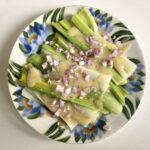 A classic French bistro dish that’s particularly pleasant in winter is leeks in vinaigrette sauce. It’s incredibly quick and easy to make at home, and there are many variations: with mustard vinaigrette, balsamic vinaigrette, lemon vinaigrette, topped with shallots or not, topped with herbs or not, topped with chopped egg or not etc. etc. In today’s recipe, the leeks are steamed, then topped with mustard vinaigrette, chopped shallot and chopped parsley.
A classic French bistro dish that’s particularly pleasant in winter is leeks in vinaigrette sauce. It’s incredibly quick and easy to make at home, and there are many variations: with mustard vinaigrette, balsamic vinaigrette, lemon vinaigrette, topped with shallots or not, topped with herbs or not, topped with chopped egg or not etc. etc. In today’s recipe, the leeks are steamed, then topped with mustard vinaigrette, chopped shallot and chopped parsley. The recipe for these fluffy little pancakes came to me via my Grandma Anne, whose family hailed from a small Jewish village in Ukraine. She called them ‘cottage cheese pancakes’, which always baffled me since cottage cheese has curds and the cheese in these pancakes was perfectly smooth. Eventually, after spending time in the Soviet Union, I worked out that the original cheese involved must have been tvorog, a smooth white cheese.
The recipe for these fluffy little pancakes came to me via my Grandma Anne, whose family hailed from a small Jewish village in Ukraine. She called them ‘cottage cheese pancakes’, which always baffled me since cottage cheese has curds and the cheese in these pancakes was perfectly smooth. Eventually, after spending time in the Soviet Union, I worked out that the original cheese involved must have been tvorog, a smooth white cheese. Who invented butter-almond crescents, the sugar-dusted confections served at Christmas time in many parts of the world? Some say the cookies were invented by a Viennese baker who adopted the shape of the Ottoman flag’s crescent moon to celebrate victory over the Turks in the 17th century. But I’m not so sure, as crescent almond cookies exist far beyond Vienna. In North Africa, for example, they’re called gazelle horns…
Who invented butter-almond crescents, the sugar-dusted confections served at Christmas time in many parts of the world? Some say the cookies were invented by a Viennese baker who adopted the shape of the Ottoman flag’s crescent moon to celebrate victory over the Turks in the 17th century. But I’m not so sure, as crescent almond cookies exist far beyond Vienna. In North Africa, for example, they’re called gazelle horns… A nice warm bowl of silky-smooth soup of sweet potato and leek with coconut milk, lime juice and spices might be just what the doctor ordered as we head into December. I came up with this one when a glitch in this year’s Thanksgiving plans left me with an abundance of uncooked sweet potatoes. It was a cinch to make — took less than half an hour — and the result was a very soothing soup with Asian flavors that was both healthy and economical.
A nice warm bowl of silky-smooth soup of sweet potato and leek with coconut milk, lime juice and spices might be just what the doctor ordered as we head into December. I came up with this one when a glitch in this year’s Thanksgiving plans left me with an abundance of uncooked sweet potatoes. It was a cinch to make — took less than half an hour — and the result was a very soothing soup with Asian flavors that was both healthy and economical. Returning to the sweet potato-leek soup, it may be served at lunchtime, accompanied by sandwiches or a salad, or as a first course for a more elaborate meal. My daughter and I enjoyed it for lunch with
Returning to the sweet potato-leek soup, it may be served at lunchtime, accompanied by sandwiches or a salad, or as a first course for a more elaborate meal. My daughter and I enjoyed it for lunch with 

